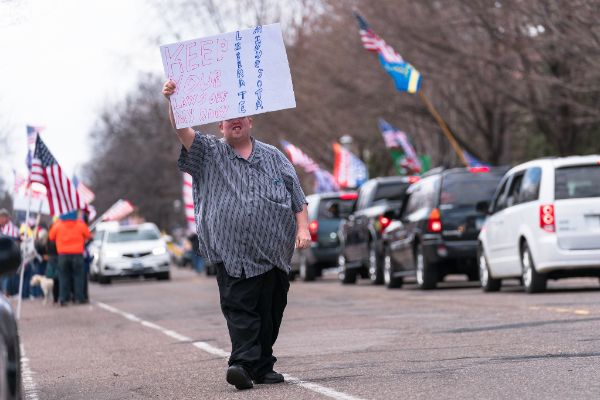The far right, both in Europe and the United States, has a long history of politicizing public health, casting immigrants as vectors for disease and infection, as pollutants of the body politic: poisoners of the physical and moral health of race and nation. Unsurprisingly, far right actors, who have previously seized upon tuberculosis and Ebola, and every disease in-between, to promote their agendas, were quick to capitalize upon the Coronavirus (COVID-19) pandemic too, though their responses have varied widely across countries.
Mixed luck and varied response
Ironically, the rapidity of COVID-19’s spread, and the tough measures enacted by European governments to combat it, including border closures and immigration restrictions, has marginalized many far right parties at the very moment many of their policy goals have been achieved, albeit only temporarily and in response to this unprecedented crisis in public health. Where they already held power, European radical right leaders like Hungary’s Victor Orbán used the crisis as a pretext to consolidate his own position, crushing democracy to rule by decree, with no apparent sunset clause on that power. Elsewhere, however, political success has alluded those parties outside of government, like Alternative für Deutschland in Germany, who have found themselves sidelined, for the time being, as the public, by-and-large, has reposed its trust in government (which has enjoyed a spike in popularity) to resolve the crisis. In Italy, Matteo Salvini, his Lega party eclipsed during the pandemic, staged a sit-in at the Italian parliament, which critics dismissed as a stunt to regain lost visibility.
Beyond party politics, the far right response to COVID-19 has, more broadly, ranged from denial to apocalypticism. For some, like prominent US conspiracy theorist Alex Jones, it was an opportunity to push quack “cures” which led the Food and Drug Administration to order him to stop making bogus claims about products marketed on his show. For others the pandemic afforded an opportunity to advance longstanding anti-vaccine agendas, now incorporating a concerted effort to sow distrust about any future inoculation efforts to combat COVID-19 whilst those who “categorically reject” vaccination clearly pose an ongoing threat to public health. There are some indications of a growing convergence between the far right and anti-vaccination protestors who represent a voluble component of US anti-lockdown protests.
The more outlandish of these anti-vax ideas claims that Bill Gates, the Microsoft founder who had committed $100 million of his own money to fight the disease, did so because he has a secret agenda to “rule the world with vaccines.” Others have accused Gates of wanting to “microchip” people under the guise of alleviating the pandemic in order to “track” them. Extreme right Telegram groups meanwhile have circulated email addresses and passwords of employees of the Gates Foundation, the World Health Organisation and Center for Disease Control and a virology center in Wuhan, China, in a bid to intimidate them, though these come from an older data breach.
Digital activism during the lockdown
The grassroots far right, which traditionally relies upon public meetings, demonstrations, and concerts, for mobilization, has, like everyone else, had its activities curtailed by the bans on social gatherings implemented by nearly all European states. Pushed online, where they had always maintained an outsized presence anyway, the far right quickly found innovative ways to continue pushing their message, though some platforms and websites have struggled to maintain their operations as regular subscribers reel from the economic crunch.
In Germany, PEGIDA sought to overcome its inability to march, a ritualized activity that has sustained the group since 2014, by shifting its activities to YouTube, with varied success. COVID-19 also deprived neo-Nazi bands of the opportunity to perform live (and curtailed their revenue streams) but it did not stop them propagating their ideology through the release of professional coronavirus themed music videos. Nor has it prevented entrepreneurial activists from using mordant racist humour to sell sweaters with integrated Klan hoods to comply with social masking measures. In the US, several people have provocatively protested COVID-19 safety measures though fashion, openly wearing Klan hoods and Nazi masks to do grocery shopping. Others have found ways of exploiting the security weaknesses in Zoom, the video conferencing platform that has become ubiquitous since lockdown measures were announced, to gatecrash online university classes, gatherings for women of colour, and virtual meet-ups of synagogue congregants, to racially harass those they can no longer physically reach.
On the extreme right fringe, numerous “accelerationist” Telegram channels were discussing COVID-19 from almost the moment it appeared in China; pushing the idea that the further spread of the virus could help collapse “the system,” a prospect they gleefully embraced. Taking such nihilism seriously also requires keeping it in perspective. There is currently no evidence of extreme right activists willingly contracting the disease, and then going out and spreading it to others, despite excitable online chatter, though the consequences of someone deliberately infecting another person are all too real. Despite the enthusiasm for the virus expressed by such cliques, as COVID-19 reached pandemic proportions other activists had pause to rethink previously articulated positions, particularly as the logical conclusion of some of the more anti-human strains of far right ecology became apparent. “I am fighting for my race against its enemies, not the planet against humanity,” noted one prominent ideologue.
Disinformation and conspiracy theories
Across the West and beyond the spread of COVID-19 has been used by an array of actors from individuals to States, particularly Russia and China, to push disinformation and conspiratorial narratives regarding the virus. One recent study, conducted between 27 February and 12 March, found that 18 million of the 40 million tweets about COVID-19 during that period were “manipulated to push harmful narratives to the public.” This is likely just the tip of the iceberg. In a wider sense, much of this is not new. Many of those denying the pandemic have previously denied climate change. For the far right in particular, fear and uncertainty about COVID-19 has provided the ideal opportunity for recycling their enduring conspiracy theories against “Jews” and “Muslims” not to mention the perceived perils “Globalism” and liberalism which are also blamed for the pandemic.
Anti-Semites have simultaneously claimed that the virus is “fake” – a Jewish conspiracy; that it’s real, but serves a malevolent end; that the “Jew flu” is spread by them; that Jewish deaths are to be celebrated; and that even more could be killed through a “Holocough”. Likewise, COVID-19 has provided further opportunities for anti-Muslim politicking. Numerous ideologues have taken to social media to falsely claim that mosques are failing to abide by social distancing regulations, disseminating video footage of worshippers purporting to prove this, though such clips, shorn of context, were taken long before the outbreak.
Several activists, motivated by conspiratorial narratives and far right beliefs, crossed the Rubicon from thought to action. In the US, one extremist, known to use extreme right Telegram channels, was killed during a confrontation with FBI agents investigating him for plotting to bomb a hospital caring for COVID-19 patients in Kansas in order “to create enough chaos to kick start a revolution.” In Los Angeles meanwhile, another man derailed a train, travelling at full speed, close to the hospital ship USNS Mercy so that the resultant media coverage would “wake people up” to his belief that “the ship is not what they say it’s for.” With US militia groups, amongst others, becoming increasingly agitated by the lockdown, the Department of Homeland Security warned that COVID-19 had “created a new source of anger and frustration for some individuals” providing the “impetus” for future episodes of domestic terrorism against “targets symbolic of their personal grievances” be they racial or anti-government.
In the UK meanwhile, conspiracy theories about 5G mobile cellphone masts being used to spread the virus, or as a ruse to allow government to curtail civil liberties, have come to predominate, leading to at least 20 phone masts being destroyed in arson attacks, some serving NHS hospitals, whilst telecoms engineers have received “murder threats.” Such incidences have also occurred in the Netherlands and Canada. Those disseminating such ideas are not confined to the conspiratorial fringe, social media “influencers” and celebrities have also spread such disinformation. British counterterrorism police have been monitoring the diffusion of such false claims “very closely” – fearing that they are being used as a “hook” to draw people into far right chat forums where they can then bombard them with their real ideological concerns, radicalizing them further.
Of particular concern, as far right propaganda efforts increase, is that social distancing measures and self-isolation measures have simultaneously led to a commensurate decline in the ability of some young people, who are now spending more time online than ever, to access the requisite sources of support. Whilst there is evidence of increased engagement online with extremist material, simultaneously lockdown measures have deprived young people of access to teachers or youth workers who could divert them from becoming involved with extremist groups. In the UK, for instance, this appears to be one reason for the collapse in referrals for both far right and Islamist youth to the government’s anti-radicalisation programme, Prevent, since the lockdown.
Politicizing the pandemic
COVID-19 ’s origin in China has fueled numerous incidences of racist, anti-Asian violence in Europe, the US and Australia. This only magnifies the often overlooked but nonetheless pervasive Sinophobia of many far right groups, particularly in the US, who have been railing against the “yellow peril” since the 1930s. In the US, Republican and far right commentators alike, emboldened by President Trump, were quick to seize on the “Wuhan virus” (which Trump’s administration sought to bully the G7 to accept as COVID-19 ’s official designation) as an excuse to pursue pre-existing anti-immigration agendas. Temporary orders to suspend immigration are in reality part of a strategy to reduce overall migration regardless of the pandemic. Trump’s deliberate politicization of the crisis aimed both to deflect attention away from his own lamentable handling of the pandemic (which he had initially dismissed as a “new hoax”) and to energize his nativist base ahead of his Presidential re-election campaign. The latter motive was particularly transparent in Trump’s deliberate fueling of anti-lockdown protests with a series of tweets demanding that demonstrators “LIBERATE” several states (coincidentally key swing states with Democratic governors) from the supposed tyranny of measures that his own White House had imposed.
The visual aesthetics of these demonstrations was strangely redolent of past far right protests: Placards proclaiming “social distancing = communism” recalled older paradigms from the 1950s declaring that “racial integration = communism” thereby underscoring the basic historical continuity of such narratives. As demonstrations in Michigan highlighted, supposedly spontaneous protests by “ordinary” citizens have in fact been a magnet for far right groups, “patriot” militias, anti-vaccination groups, and Christian fundamentalists, whilst the protests themselves have often been funded by wealthy Republican backers who have their own reasons for wanting to “re-open” America.
Some protests have gone further with far right activists threatening people who have reported lockdown violations, whilst others have consisted of armed militias helping non-essential businesses to stay open, actively flouting state-imposed restrictions, which, they argue, violate their Constitutional rights. The protests themselves, a flashpoint for confrontation between anti-government protestors of all stripes and the authorities, have become increasingly menacing given the presence of a rising number of armed groups at these demonstrations. Many of these have been actively talking up the prospect of the lockdown sparking the “Boogaloo” – the latest term invoked by such actors to describe an impending civil conflict and/or race war. With several instances of violence connected to “Boogaloo Bois” already documented, there are fears that violence could escalate the longer the lockdown endures. The size of such protests has, however, been distorted by a disproportionate amount of media coverage they have garnered; the numbers attending them have been tiny compared to the overwhelming majority of Americans who support “stay-at-home” measures to mitigate the impact of the virus. Epidemiologists have warned that such anti-lockdown protests could led to a “new epidemic surge,” a fear that gains credence from news that 72 people who had contracted the virus in Wisconsin had previously attended a “large gathering” which, possibly, though not conclusively, was a recent anti-lockdown protest.
A “new normal” after the pandemic?
COVID-19 will likely have a lasting impact on our societies. The far right, in all its various forms, thrives on crisis. Thus, although far right efforts to use the virus to its own political advantage has so far been mixed, a range of groups are already positioning themselves to take advantage of the deep-seated economic dislocation and damage wrought by the virus. More broadly, such actors will undoubtedly make every effort to capitalize on the anguish and anger that many people undoubtedly already feel as their countries tentatively ease lockdown restrictions. With many countries already blaming China, a sustained increase in anti-Asian sentiment remains a possibility, as does an increase in anti-immigrant and xenophobic sentiment more generally. UN Secretary General António Guterres has already warned that the virus has unleashed a “tsunami of hate and xenophobia.”
Emerging evidence, which suggests ethnic minority communities are being disproportionately affected by the virus in some countries, likely a result of underlying social deprivation and health inequalities, will undoubtedly be used by the far right to reinforce racist arguments and conspiracy theories linking public health to immigration and to blame ethnic minority communities for the spread of COVID-19. Looking forward, once the lockdown ends, these positions, coupled with what appears to be a grim economic forecast, will undoubtedly add further grist to the mill, as the far right utilizes the virus to buttress its arguments for immigration restriction and closed borders, as part of its wider, ongoing assault on liberal democracy.
.jpg)




